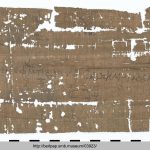| Artefact ID | 1720 |
| TM ID | TM 33802 |
| Findspot (DEChriM ID) | 28 (al-Bahnasā) | Class | Textual |
| Material | Papyrus |
| Writing medium | Sheet/roll |
| Text content | Documentary |
| Language | Greek |
| Description | P.Berl. 14897, SB 3 7243, SB 8 9746: Letter from Didyme and the “sisters” to Sophias |
| Selection criteria | Christian terms/formulas/concepts, Christian onomastics, Nomina sacra |
| Date from | 300 |
| Date to | 350 |
| Dating criteria | Palaeography; Wipszycka 2002 limits it to before 340, when the talent collapsed. Blumell/Wayment 2018 compare the hand to P.Oxy. LXVI 4528 (6 May 336), P.Col. VII 147 (6 April 342) and P.Abinn. 47 (1 May 346). |
| Absolute/relative date | Relative date |
| Archaeological context | Unknown acquisition, from al-Bahnasā (Oxyrhynchos). |
| Accession number | Berlin, Staatliche Museen, Ägyptisches Museum und Papyrussammlung P. 13897 |
ARTEFACT IDENTIFIERS
Editio princeps
• Manteuffel, Georgius [Jerzy]. 1927. “Epistulae Privatae Ineditae.” Eos: commentarii Societatis philologae Polonorum = Eos: organ Polskiego Towarzystwa Filologicznego 30. 211-215: 211-214, No. 1.
Additional bibliography (in chronological order)
• Bilabel, Friedrich. 1927. Sammelband Griechischer Urkunden aus Ägypten. Dritter Band. Zweite Hälfte. Urkunden Nr. 6001 bis 7269. (SB 3). Berlin/Leipzig: De Gruyter. 253-254, No. 7243.
• Wilcken, Ulrich. 1930. “Urkunden-Referat.” Archiv für Papyrusforschung (AfP) 9. 63-104: 97-98.
• Olsson, Bror. 1932. “Zwei Papyrusstellen besprochen.” Aegyptus 12. 355-356: 355, No. 1.
• Cavassini, Maria Teresa. 1954. “Lettere cristiane nei papiri greci d’Egitto.” Aegyptus 34. 266-282: 269, 273, 274, 276.
• Kiessling, Emil. 1965. Sammelband Griechischer Urkunden aus Ägypten. Achter Band. Erstes Heft. (Nr. 9642–9825). (SB 8). Wiesbaden: Harrassowitz. 85-86, No. 9746.
• Naldini, Mario. 1968. Il Cristianesimo in Egitto. Lettere private nei papiri dei secoli II-IV. Firenze: Le Monnier. 173-177, No. 36.
• Tibiletti, Giuseppe. 1979. Le lettere private nei papiri greci del III e IV secolo d.C. Tra paganesimo e cristianesimo. Milano: Vita e Pensiero. 15, 43, 68.
• Goehring, James E. and Robert F. Boughner. 1990. “Egyptian Monasticism (Selected Papyri).” In Ascetic Behavior in Greco-Roman Antiquity: A Sourcebook, edited by Vincent L. Wimbush. Minneapolis: Fortress Press. 456-463: 462-463.
• Brakke, David. 1995. Athanasius and the Politics of Asceticism. Oxford: Oxford University Press. 28-29, 37, 40-41.
• Elm, Susanna. 1996. Virgins of God. The Making of Asceticism in Late Antiquity. Oxford: Oxford University Press. 236-237, 241-244.
• Gonis, Nikolaos. 1997. “Remarks on Private Letters.” Zeitschrift für Papyrologie und Epigraphik (ZPE) 119. 135-147: 142-144.
• Wipszycka Ewa. 2002. “Del buon uso delle lettere private. Commento a SB III, 7243 e P. Oxy. XIV, 1774.” In "Humana sapit". Études d'Antiquité tardive offertes à Lellia Cracco Ruggini, edited by Jean-Michel Carrié and Rita Lizzi Testa. Bibliothèque de l'Antiquité tardive 3. Turnhout: Brepols. 469-473, 484.
• –––. 2005. “IX. Letters Dated Early or First Half IV. A. With ‘Nomina Sacra’ or Other Decisive Indications of Christian Identity.” Papyri from the Rise of Christianity in Egypt: Draft Conspectus. (PCE.IX.A). Macquarie University. 8, No. 105. [http://www.mq.edu.au/pubstatic/public/download/%3Fid%3D45105&usg=AOvVaw2xqK_R6N3vQdQpC4Mq_iMD]
• Choat, Malcolm. 2006. Belief and Cult in Fourth-Century Papyri. Studia Antiqua Australiensia 1. Turnhout: Brepols. 158.
• Bagnall, Roger S. and Raffaella Cribiore. 2006. Women's Letters from Ancient Egypt, 300 BC–AD 800. Ann Arbor: University of Michigan Press. 196-197.
• Bagnall, Roger S. and Raffaella Cribiore. 2008. Women's Letters from Ancient Egypt, 300 BC–AD 800. Ann Arbor: University of Michigan Press. A13.2. [https://hdl.handle.net/2027/heb90014.0001.001]
• Albarrán Martínez, María Jesús. 2010. Prosopographia Asceticarum Aegyptiarum. Madrid: Consejo Superior de Investigaciones Científicas (CSIC). 97–98.
• Blumell, Lincoln H. and Thomas A. Wayment. 2015. Christian Oxyrhynchus: Texts, Documents and Sources. Waco TX: Baylor University Press. 527-533, No. 144.
• Emmett, Alanna M. 2017. “An Early Fourth-Century Female Monastic Community in Egypt?” In Maistor. Classical, Byzantine and Renaissance Studies for Robert Browning, edited by Ann Moffat. Byzantina Australiensia 5. Leiden/Boston: Brill. 77-83.


 Json data
Json data





